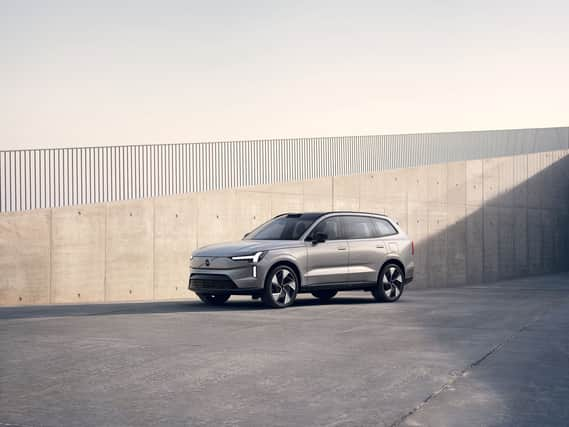Volvo EX90: price, range, performance and safety specification for flagship electric SUV


Volvo has lifted the wraps from what will become its flagship electric car, the EX90. And it’s hugely significant, even for the Swedish carmaker. Why? Well for a company renowned above everything else for its safety, new company boss Jim Rowan has stated simply: “The EX90 sets new standards for safety: it’s a statement of where we are, and where we are going.”
Effectively an all-electric equivalent to the current Volvo XC90 (which will continue to be sold in parallel with the new EV SUV), the EX90 which will be a true seven-seater, and capable of covering up to 373 miles on a single charge. It is the company’s third electric car following the XC40 Recharge and C40 Recharge. The newcomer, though, is the first to sit on a new dedicated platform, the SPA2 architecture, already seen on Polestar 3 and produced by Volvo’s parent company, the Geely Group.
Advertisement
Hide AdAdvertisement
Hide AdCentral to Volvo’s safety ambitions is the addition of Lidar as standard. Lidar is the technology which determines ranges by targeting an object or a surface with a laser and measures the time for the reflected light to return to the receiver. Why is it important? Most specifically at night, it will detect potential dangers way ahead of the car in the dark and alert the driver to their existence, allowing more time for reaction.
Already an option on the Polestar 3, from Volvo’s sister company, the Lidar sensor will be mounted on the front edge of the EX90’s roof. It will work in tandem with a range of other internal and external sensors and cameras to power advanced driver assistance and safety options. Initially these systems will include a steering support function that will help changing lanes, plus an upgraded Pilot Assist system. Eventually, according to Volvo, the systems will deliver an over-the-air subscription update that will offer “unsupervised autonomous driving”. This facility, of course, will only be operable in certain conditions and places.
Also included in what Volvo calls the EX90’s “invisible shield of safety”, are interior sensors which can gauge eye concentration. Powered by Volvo’s own in-house-developed algorithms, the technology allows the EX90 to understand when the driver is distracted, drowsy or otherwise inattentive, beyond what has previously been possible in a Volvo car. Its first reaction is to softly nudge the driver. If that’s not enough, it will become more “insistent”. And if the unthinkable happens and the driver falls asleep or is taken ill while driving, the EX90 is designed to safely stop and call for help.
The safety kit, alongside that of the infotainment and battery management systems will be powered by a core software system that uses advanced Nvidia Drive platforms. This will work in tandem with Qualcomm’s Snapdragon Cockpit platform mixed with in-house Volvo software. I know that sounds very techie, but Volvo has taken the stance that EX90 won’t be just a new car, “it will be a highly advanced computer on wheels”. Expect lightning-fast computing power and high-quality graphics on the in-car screens and head-up display.
Advertisement
Hide AdAdvertisement
Hide AdWith Google built in, the 14.5-inch portrait infotainment touchscreen features a 5G connection as standard and sits at the heart of the largely-button free, minimalist cabin. In addition to a variety of Google apps, plus Apple CarPlay and Android Auto compatibility, there’s also a Bowers & Wilkins Dolby Atmos-enabled stereo. The EX90 is than five metres long and comes with seven seats as standard. With the rear seats up it will have a bootspace of 310 litres, rising to 655 litres in five-seat configuration. If you have just the front row of seats in place, you can carry a humungous 1,915 litres of detritus.


At launch, the EX90 will come with a choice of two dual-motor powertrain options, both equipped with a 107kWh battery. The entry-level Twin Motor delivers 402bhp and 568lb ft of torque and, considering the EX90 tips the scales at 2,818kg, propels the big SUV from standstill to 62mph in just 5.9 seconds. Step up to the more expensive Twin Motor Performance, and thanks to its 510bhp and 671lb ft of torque you can shave a full second off the 0-62mph time. Both versions are limited to a top speed of 112mph. With 250kW DC charging, you’ll be able to top-up from 10-80% in 30 minutes and bi-directional charging capability means uses can power external electrical appliances from its battery, with the theoretical potential to feed power back to the grid.
Prices for the Twin Motor Ultra will start at £96,255, while Twin Motor Performance Ultra model will start at £100,555. So it’s certainly not cheap, and is a significant step up for Volvo in terms of pricing but expect an entry-level EX90 to arrive in the future, probably priced from around £75,000. As for availability, expect sales to start in spring next year.